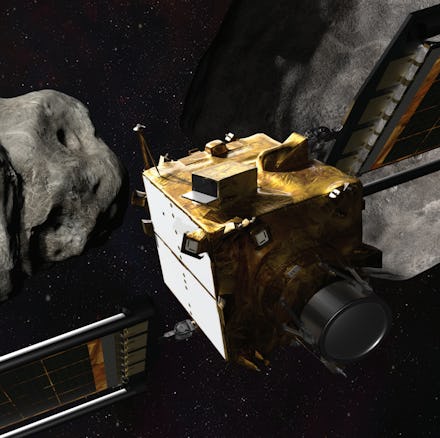NASA is about to test out a new defense against Earth-killing asteroids
Our national space agency wants to play real-life Galaga.

Of all the fears baked in to being a Millennial of a Certain Age, none has stuck with me quite like the Hollywood-hyped prospect of life as we know it ending in a bang when a giant fragment of rock and ice comes hurtling out of the inky depths of space to slam into the crust of our planet. I, and plenty more like me, grew up at a time when the film industry couldn’t help but hype a scenario in which an asteroid impact would kill millions of humans instantly, while dooming the rest of our species to a slow death from a dust-induced ice age. Bruce Willis gallantly sacrificed himself to save the Earth from this apocalyptic fate in Armageddon, while Elijah Wood survived to watch helplessly as an extinction level event destroyed the entire Eastern Seaboard in Deep Impact.
In part, these doomsday scenarios were so terrifying to my overactive imagination because I knew that no matter how much Hollywood overdramatized the possibility of death from above, it was still not wholly out of the realm of possibility. You don’t see many dinosaurs around these days, y’know?
Fortunately, my residual adolescent anxiety over a planet-killing asteroid will be given a brief reprieve this week with the scheduled debut of NASA’s “Double Asteroid Redirection Test” (DART) mission. Launching Tuesday evening from Vandenberg Space Force Base in California, the DART spacecraft is, per NASA, “the first demonstration of the kinetic impactor technique to change the motion of an asteroid in space.” That, in slightly less rocket science-y terms, means that for the first time ever, NASA is flinging one of its fancy robots into a far off asteroid to see if it can smash it into a slightly different direction. Wham, bam, planet saved.
“This technique is thought to be the most technologically mature approach for mitigating a potentially hazardous asteroid,” NASA’s planetary defense officer Lindley Johnson explained in a press release ahead of DART’s launch. “It will help planetary defense experts refine asteroid kinetic impactor computer models, giving insight into how we could deflect potentially dangerous near-Earth objects in the future.”
Crucially, DART’s intended target isn’t actually an active threat to our planet. The spacecraft will be slamming into Dimorphos, a 160-meter chunk of rock orbiting Didymos, a larger asteroid measuring in at almost three-quarters of a kilometer. The hope is that DART — which is only about the size of a car — will hit the asteroidlette hard and fast enough so that telescopes on Earth can measure if and how much Dimorphos’s orbit around Didymos is affected. That all comes later, though. If this week’s launch goes off without a hitch, DART isn’t scheduled to smash into Dimorphos for almost a year — or sometime this coming September.
In the meantime, there aren’t any prospective planet-killing pieces of space rock headed our way between now and then ... that we know of. But I’ll be keeping one eye on the skies all the same.